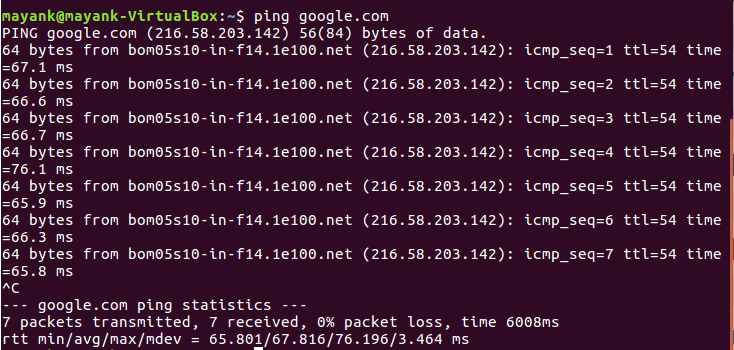Network configuration and troubleshooting commands in Linux
Last Updated :
01 Apr, 2024
Computers are often connected to each other on a network. They send requests to each other in the form of packets that travel from the host to the destination. Linux provides various commands from network configuration and troubleshooting.
Network Configuration and Troubleshooting Commands in Linux
Using Ping (Packet Internet Groper) Command
The ping command is used to ensure that a computer can communicate with a specified device over the network. The pings command sends Internet Control Message Protocol (ICMP) Echo Request messages in the form of packets to the destination computer and waits in order to get the response back. Once the packets are received by the destined computer, it starts sending the packets back. This command keeps executing until it is interrupted.
ping command provides details such as
- the number of packets transmitted.
- the number of packets received.
- time is taken by the packet to return.
ping command is generally used for the following purposes:
- measuring the time taken by the packets to return to determine the speed of the connection.
- to make sure that the network connection between the host and the destined computer can be established.

ping google.com

ping an IP
Using nslookup Command
The nslookup command queries the DNS in order to fetch the IP address or the domain name from DNS records.

nslookup facebook.com
Using traceroute Command
The traceroute command is used to get the route of a packet. In other words, the traceroute command is used to determine the path along which a packet travels. It also returns the number of hops taken by the packet to reach the destination. This command prints to the console a list of hosts through which the packet travels in order to the destination.

traceroute www.google.com
Using host Command
The host command is used to find a domain name associated with the IP address or find an IP address associated with the domain name. The returned IP address is either IPv4 or IPv6.

host google.com

host 31.13.78.35
Using netstat Command
The netstat (Network Statistics) is the command that is used to display routing tables, connection information, the status of ports, etc. This command works with Linux Network Subsystem. This command basically displays the content of /proc/net file defined in the Linux file system.

netstat

netstat -r
Using Arp Command
The ARP (Address Resolution Protocol) command is used to display and modify ARP cache, which contains the mapping of IP address to MAC address. The system’s TCP/IP stack uses ARP in order to determine the MAC address associated with an IP address.

arp

arp -e
Using ifconfig Command
The ifconfig(Interface Configuration) is a utility in an operating system that is used to set or display the IP address and netmask of a network interface. It also provides commands to enable or disable an interface. Many UNIX-like operating systems initialize their network interfaces using ifconfig at boot time. ifconfig is also used to view the MTU(Maximum transmission unit).

ifconfig
Using Dig Command
The Dig Command is called domain information groper; it is a tool used to find query information related to domain name and troubleshoot DNS issue in Linux. This tool can provide various types of DNS records, such as CNAME, MX records and records etc.
For example: If we want to query a record for “google.com”
Syntax:
dig A google.com

dig A google.com
This will show the IP address associated with the domain name.
Using Route Command
The Route Command tool helps us display and manipulate the routing table in Linux. Information contained by this is about how network packets should be routed through a network.
Syntax:
route

route
This command shows destination, mask, flags, metric, gateway, reference count, and interface. We can also add or delete routes from a network with IP address.
For example: If we have “IP address: 192.168.90.0” and “Subnet mask = 24” and “gateway (gw) = 10.0.0.1”
Syntax:
route add -net 192.168.90.0/24 gw 10.0.0.1
The Ethtool is used to view and modify the settings of a network interface card (NIC) in Linux. It has replaced the old tool named mii-tool. This command can be used to view the current speed and duplex setting of the NIC. To view the settings for the NIC named “enp0s3” use the following command.
Syntax:
enthool enp0s3
You can find your NIC name by using “ifconfig” command.

Ethtool
Using Hostname Command
The Hostname command is used to display the current hostname of the system.

Hostname
We can also change our host name by using commands.
syntax:
hostnamectl set-hostname mypc
This will set the hostname to “mypc” and display it after reboot also.
Conclusion
Computer networks are essential for communication and data transfer between devices and in Linux we get various commands to configure and troubleshoot network-related issues. Commands that we have mentioned in the article are ping, nslookup, traceroute, host, netstat, ARP, Dig, Route, Ethtool, Hostname and ifconfig. With these commands one can fix network problems by diagnosing them.
Share your thoughts in the comments
Please Login to comment...